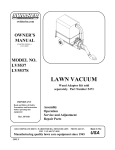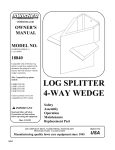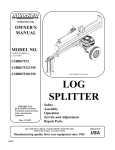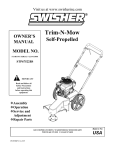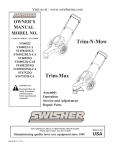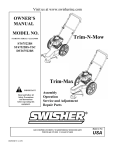Download REPAIR MANUAL ZT2560 - Pdfstream.manualsonline.com
Transcript
REPAIR MANUAL ZT2560 Swisher Mower Co Warrensburg, MO TABLE OF CONTENTS 1. If engine won’t crank 2. If engine won’t crank – continued 3. If engine cranks but won’t start If engine stalls when PTO is engaged 4. If PTO clutch will not engage Hour meter not operating 5. Wire identification at switches 6. Wire identification at switches – continued 7. Drive control adjustment 8. Drive control adjustment – continued Drive control overview 9. Electrical components 10. Parking brake and neutral switch operation 11. Deck lifting system 12. Deck belt replacement 13. Repairing or replacing blade driver 14. Replacement Parts – Quick reference IF ENGINE WON’T CRANK ALWAYS CHECK FUSE FIRST TEST #1 Using a remote starter switch or suitable device, make a connection between the large terminals on the solenoid. If engine does not crank!!! •Battery may be weak or dead •Starter may be bad •Battery cables may have bad connections •Do not go to Test #2 until this test gives results TEST #2 If engine did crank in test #1, disconnect green wire at spade connector and apply positive voltage from the battery to the primary wire on the solenoid. Make sure the one with the eyelet is grounded. If engine doesn’t crank now, replace the solenoid. Remember, all other tests are useless unless these two tests make the engine turn over. TEST #3 If engine did crank in the first part of test #2, reconnect green wire to solenoid. Make sure the drive controls are out in neutral position. Using a jumper wire attached to the positive terminal of the battery, apply 12 volts to the red wire on terminal B of the ignition switch. Try to crank, using the ignition switch. If engine cranks, the fuse or the fuse holder, or related wiring is defective somewhere back to the solenoid. TEST #4 If engine did not crank in test #3, make sure the drive controls are in neutral position. This time move the jumper wire attached to the positive terminal of the battery, to the green wire on S terminal of the ignition switch. If all components in the circuit are working, the engine should crank. If it doesn’t, move on to next test. 1 A neutral switch is located on the lower end of both drive control handles and is activated when the handles are outward in the neutral position. Check that the plunger buttons on both switches are depressed at least 3/8”. Meter should go to zero when checking continuity across switch terminals with plungers depressed. If any of the switches in this circuit tested bad, install a new one and perform Test #4 again. If all switches are good, a connecting wire must be at fault. Don’t move past Test #4 until it assures a good circuit. When you do get good results, hook all wires back to original position and try the ignition switch again. If no results, you will need to replace the ignition switch. 2 With PTO switch in the off position, meter should go to zero when checking continuity across these two terminals. ENGINE CRANKS BUT WON’T START Checks for electrical problems •While turning ignition switch to its first position, listen for the fuel solenoid on the carburetor to click. It must click to supply fuel to the carburetor. •Try a new spark plug. •Check for spark at plug when it is removed and the threaded end is grounded. •Unplug the six-position socket that connects engine wiring to mower wiring harness. Engine will still crank. If plug doesn’t have a spark now, ignition module is probably defective. Checks for mechanical problems •Make sure the tank gas valve is turned on. •Remove air filter element to check for signs of gas in the throat of the carburetor. •If no gas, check to see if choke is working properly. •If all above checks show positive, carburetor must have an internal problem. Remove and clean the carburetor. ENGINE STALLS WHEN PTO IS ENGAGED The seat safety switch plug not being properly inserted, or a defective plug can cause this problem. If the plug is not inserted or is defective, the spark plug is grounded out when the PTO is engage. To check, remove plug from the PTO switch. Using an ohmmeter, place one probe on the terminal connected to the black wire going to the seat safety switch plug. Place the other probe on a good chassis ground. The meter should be on zero with no weight on the seat. Pulling the seat down should open the circuit. 3 IF PTO CLUTCH WILL NOT ENGAGE Apply a negative ground to this terminal Apply 12 volts to this terminal. Clutch should activate, if it doesn’t, clutch is defective. If clutch checks OK, use a voltmeter to measure if there is 12 volts at the brown wire’s terminal. First turn ignition switch to the ON position but don’t start the engine. Now engage the PTO switch. For the first test put the negative probe on a good ground, not on the white wire’s terminal in the plug. If no voltage is measured, move on to next test. With the PTO switch ON there should be continuity between these two connectors, if not, replace switch. If switch tested good, check wires and connectors back to ignition switch and back to clutch plug. If all checked good in the two previous tests, the problem may now be a poor ground on the white wire in the clutch plug. Check by testing for continuity to ground or check for voltage between the two terminals HOUR METER NOT OPERATING Hour meter has a positive and a negative post. Gray wire should go on the positive. Power is supplied from the ignition switch. Green wire from hour meter is grounded by the oil pressure switch, therefore only has a ground when the engine is running. 4 WIRE IDENTIFICATION AT SWITCHES 3623 IGNITION SWITCH One gray wire goes to the PTO switch and the other goes to the hour meter Green wire goes to PTO switch Red wire goes to fuse and on to battery positive at the solenoid terminal. One black wire goes to PTO switch and the other goes to the engine plug One white wire goes to clutch and other one goes to ground. STARTER SOLENOID Green wire goes to neutral switches and on to the ignition switch. Heavy red cable goes to the starter. Red wire goes to engine plug. Green wire with orange stripe goes to the ground. Heavy red cable goes to the positive post of the battery. Red wire goes to ignition switch. PTO SWITCH PLUG Black wire goes to the ignition switch. Black wire goes to the seat switch. Green wire goes to the ignition switch. Green wire goes to the neutral switches. Gray wire goes to the ignition switch. Brown wire goes to the clutch. 5 WIRING HARNESS TO ENGINE PLUG CONNECTION Gray wire goes to carburetor fuel solenoid Green wire goes to oil pressure switch Black wire goes to engine ignition module Red wire goes to engine charging system Green wire goes to hour meter Red wire goes to terminal on solenoid with the positive battery cable. Black wire goes to the ignition switch. Gray wire goes to hour meter WIRING HARNESS PLUG TO ENGINE Gray wire goes to hour meter Red wire goes to terminal on solenoid with the positive battery cable. Black wire goes to the ignition switch. Green wire goes to hour meter 6 BATTERY CHARGING SYSTEM Red wire goes to the engine plug and then on to the positive terminal of the solenoid to keep the battery charged. Easiest way to check if the charging is taking place is to measure the DC voltage of the battery before you start the engine. Then start the engine. Measure the voltage at the battery with the engine running. The voltage should be at least one volt higher right after the engine is started. This voltage will drop a little as the battery gets recharged. Voltage Regulator To test alternator before it goes to the regulator, unplug the yellow connector and measure the AC voltage across the the two gray wires inside this connector.There should be at least 20 volts AC. CARBURETOR FUEL SOLENOID Black wire goes to engine ground. Gray wire goes to the engine plug, then on to the ignition switch where it receives power to activate the fuel shut off valve. Fuel shut off solenoid is a Briggs part and is available through them only. 7 DRIVE CONTROL ADJUSTMENTS LEFT SIDE SHOWN Control plate shown in neutral position Start your adjustments by putting the drive control arms in the neutral position. Remove the linkage from the control plate at the Eaton hydro by removing the cotter pin and washer on the under side. By moving the control plate forward and backwards by hand you can easily find the neutral position on the hydro. Hydro linkage With the drive control handles in the neutral position, this linkage pivot should be close to straight up and down. With control plate on hydro still in the neutral position, try to put hydro linkage back into the hole on the plate. If it won’t go in without forcing one way or the other, adjust threads here to make an easy hookup. With the control linkage once again removed, move the control plate forward as far as it will go. Move the control handle forward until this linkage contacts the adjusting bolt in front of it.Again try to put the control linkage in to the control plate. Do not adjust the control linkage to make this happen, adjust the bolt in front instead. This adjusting bolt will now be used to set both drive wheels to pull equally. With the control handles fully forward, observe which side is turning the fastest. Extend the bolt rear ward to slow the travel of that side until they are pulling the same on both sides. 8 DRIVE CONTROL ADJUSTMENTS (CONTINUED) LEFT SIDE SHOWN Once both hydro units are pulling equally, make your final control handle adjustment with this ball linkage. Whichever handle is going the farther forward, lengthen the linkage on that side until the handles are straight across when mower is traveling in a straight line. If a lot of adjustment is needed, shorten the linkage on the opposite side for half of the adjusting. OVERVIEW OF DRIVE CONTROL LINKAGE RIGHT SIDE SHOWN Right side control handle Pivot point for control handle movement Pivot point Forward and reverse control on hydrostat Adjustment threads on control rod 9 PARKING BRAKE AND NEUTRAL SWITCH OPERATION Right side drive control handle. Parking brake cable attaches here. Right side is shown. Control panel has been removed for better view. Parking brake is activated by this bolt as the drive control handle is swung outward in the neutral position. Tension on brake cable can be adjusted by raising or lowering this bolt, but the main adjustment is performed on the other end of the cable down by the rear wheels. Safety switch rocker arm pivots on a bolt at this point. This is the neutral safety switch that prevents the engine from cranking unless the drive controls are both swung outward in neutral position. The switch has a slotted mount bracket so the travel of the push button can be adjusted to depress about 3/8” to activate. Further information about checking this switch is found in the electrical diagnosing section The parking brake can be adjusted by moving the nuts on this cable. A nut is located on each side of this frame. As the outer cable moves forward, the brake will become tighter. 10 DECK LIFTING SYSTEM Three rocker arms are activated by the deck lift handle. This is the right side control. Note the routing of the cable. It drops straight below to the deck. This center rocker arm lifts the front center of the deck. It also drops through the lower frame but is directed by two pulleys under the mower frame to the front of the deck. The deck lift system has two springs to assist in raising the deck. The ease of lifting the deck can be adjusted by tightening this nut equally on each spring. The guide pulley for the front center deck lift cable. Front guide pulley for the center lift cable. To level the deck, start by lowering the deck lift handle to its lowest position. If the deck is not setting on the ground, turn the nuts under these three brackets until it does. The left and right cables in the rear should then be tightened until the back end of the deck is level across and rides about 1\4 inch higher than the front end. 11 DECK BELT REPLACEMENT ENGINE TO DECK BELT •Lower the deck to lowest setting •Loosen tension on tension idler •Remove worn or damaged belt •Using part# 10263 belt, route it around the engine pulley as shown in the diagram. •Retighten the tension idler and check the operation Belt coming from the electric clutch will be routed around this idler pulley on the outside. As belt leaves the previous idler pulley it will be routed around this flat idler pulley to the inside and then forward to the deck. DECK CROSS BELT •Remove the belt covers •Remove the engine to deck belt from deck pulley •Loosen the tension to the tension idler •Remove the worn or damaged belt and replace with part# 5058 belt •Reinstall the engine to deck belt and retighten both tension idlers Tension on belt can be adjusted by tightening or loosening this nut. 12 REPAIRING OR REPLACING BLADE DRIVER Torque top nut to 90 ft/lbs Replacing this nut each time is recommended. Since there are no hubs on our pulleys, this Belleville washer is important to apply friction to the pulley to turn the shaft. Make sure the outer lip is down to best contact the pulley. Machine washers are used to keep the pulley from contacting the outer race of the bearing. When applying torque to the top nut the pressure is to the inner race only and onto the shank on the inner shaft. Pulley does not have a hub. When removing, just lift it off like a washer, no puller is needed. Bottom end of the shaft has the same ¾ in. SAE threads as the top end. Bearings are sealed. They can be driven out and new ones pressed in for repairing the spindle assembly. It can also be purchased as a unit for easier repair. This washer is wide enough to to cover the full bottom of the housing and is used as a protector for the seal in the bearing. This adaptor block is right hand threaded onto the ¾ in. shaft. Torque this block to 90 ft/lbs just like the nut at the top of the shaft. Machine washer used as a spacer just like those on top of the upper bearing. Install the blade adaptor block to the bottom of the shaft. Before applying torque, install the blade to the block using only the outer two bolts. Leave the center bolt out for now. Block the blade to outer deck edge by using a 4x4 or similar stop. Using a torque wrench on the top nut above the pulley, apply 90 ft/lbs. The top nut and the adaptor block will equally receive the tightening. Now put the washer on the center bolt and install into the shaft. Torque the three bolts to 35 ft/lbs. The center bolt will lock the block so it won’t come off. 13 For additional assistance on service Contact Swisher Mower Co., Inc. Phone 1-800-222-8183 Fax 1-660-747-3160 E-mail [email protected] 14



















